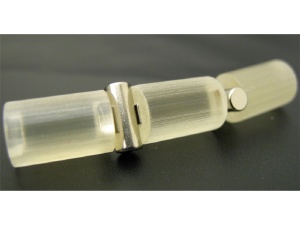Nov 29 2008
In the future, tablet-shaped robots could perform some surgical operations without injuring the body. A new publication by the Institute of Robotics and Intelligent Systems of ETH Zurich shows how such surgical bio-microrobots might function.
 A model of a self-assembling stomach robot: a magnetic mechanism connects three modules together via intermediate linkages.
A model of a self-assembling stomach robot: a magnetic mechanism connects three modules together via intermediate linkages.
Paolo Dario, Professor of Biomedical Robotics at the Scuola Superiore Sant'Anna in Pisa, Italy, explained the dawn of a new medical era in the September edition of the American financial magazine "The Economist". Surgical operations with open wounds are increasingly being replaced by non-invasive techniques extending even to systems that enable operations without a single scar.
Bio-microrobotics has a decisive role in this development. Like the Scuola Superiore Sant'Anna, ETH Zurich is also a part of the EU's ARES research project (Assembling Reconfigurable Endoluminal Surgical System), a consortium of robotics experts from four European higher education institutions. Together, the researchers want to make micro-robots usable for medical applications. The plan is that, in the future, robots no bigger than a conventional capsule will perform a series of tasks in the gastro-intestinal tract, e.g. a gastroscopy or a tissue biopsy.
Although pill-shaped micro-cameras have existed for seven years now and are currently being used successfully in surgery to study the gastro-intestinal tract, these systems are passive. The camera takes thousands of pictures as it passes through the gastro-intestinal tract, but its position during this time cannot be controlled. This should soon change, because the ARES scientists are currently developing micro-robots with controllable insect-like legs with which the "robot pills" would be able to move around in the stomach. Other groups are working on special devices for tissue biopsy. In the future, such instruments could be used to make a precise examination of damaged regions in the gastro-intestinal tract while at the same time taking tissue samples for subsequent investigation.
Multi-segment, self-assembling stomach robots
One of the biggest challenges facing the robotics scientists relates to the enormous miniaturisation of the electronic systems. Room for the system's entire technology, including the power supply, must be found within a few cubic millimetres. In the micro-cameras that are already established, the battery alone takes up 60 percent of the capsule's volume. Hence one key question: how can a series of surgical robot functions be brought into a form that the patient can swallow and which is at the same time compatible with the body?
In a recent publication, Zoltan Nagy, a doctoral student at the Institute of Robotics and Intelligent Systems of ETH Zurich (IRIS) since 2006, presents the following approach to a solution: the patient swallows not one but several "robot pills" fitted with individual functions, such as the controller or forceps for tissue sampling. The pills can be swallowed one after another and assemble themselves automatically to form a larger, more powerful system only when they reach the stomach. For this purpose, Nagy developed a magnetic mechanism that enables the parts of the robot to join together automatically in the stomach to form an entire system. The individual components are polarized at right angles to the surface, so they arrange themselves in a predictable sequence when they come together.
The system was tested in an artificial stomach with a 75 percent success rate. Because a rigid chain of several robot components moves only with difficulty through the stomach and intestine, Nagy has also developed intermediate links that make the system more mobile. This would enable the surgical system to move as a whole through the stomach and intestine, like a multi-link chain. A magnetic system has the added advantage that the magnetic field changes in a characteristic way when the individual members of the chain come together. This change is measurable and can be communicated to a computer and used as an indicator of the exact position and arrangement of the robot snake.
Probing the limits of feasibility
The use of such a system in the human body is still a long way off. Firstly, the energy supply within the precarious space conditions is still largely unsolved. However, according to Nagy, this problem could soon be eliminated by using a combination of a battery and induction. Secondly, biocompatibility presents the scientists with major challenges. If trials on humans take place one day, the scientists must be able to guarantee that the magnetic mechanism and the functions of the robots cannot cause any tissue injury. The entire system must also be capable of being dismantled into its individual parts at any time if complications occur.
This is why Nagy does not expect any in-vivo tests of his self-assembling system in the near future. In any case that is not his top priority aim. "ARES is concerned primarily with expanding the limits of feasibility in bio-microrobotics. I have presented one possible mechanism for the self-assembly of a robot that has potential for surgical application. At present, it is impossible to predict which system will gain acceptance in practice in the future."